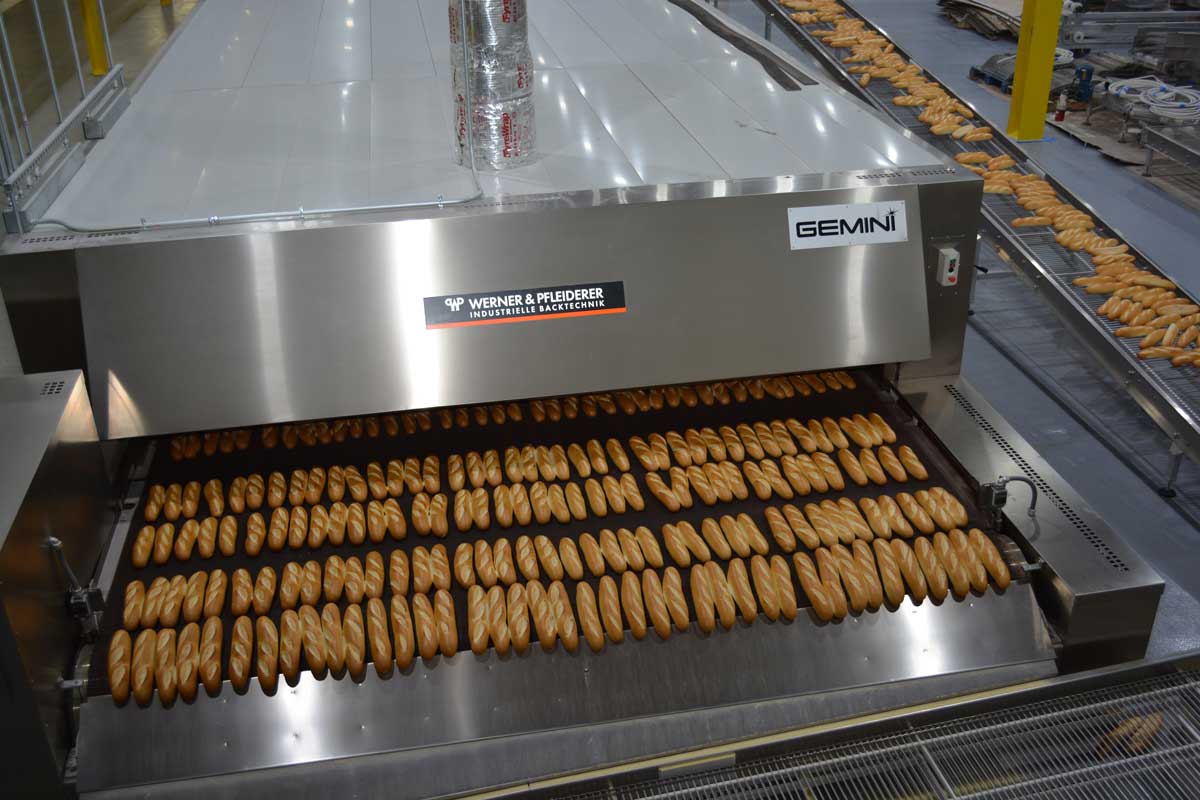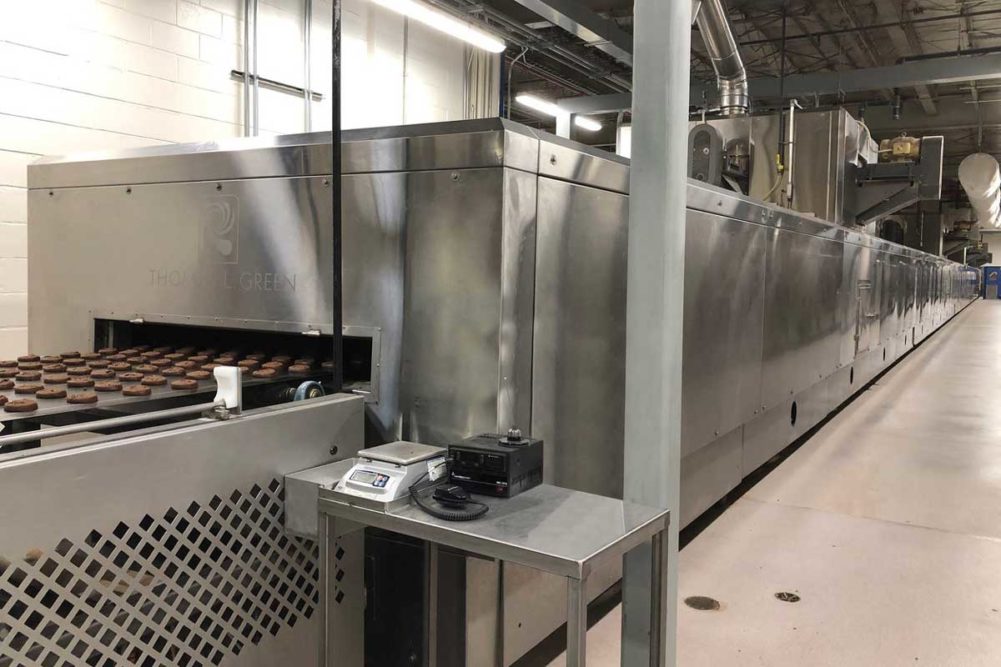On the most fundamental level, baking is as easy as 1-2-3. That’s why many 80- to 125-foot tunnel ovens provide three distinct sections for bread and other yeast-raised products. It’s also the way the heating applications work for many cookie and cracker ovens that measure upwards of 300-feet long.
The number three seems to work just fine for many baked goods such as laminated crackers, which follow a bell curve where the heat starts at one level, rises to the peak in the middle and drops down to add the hue and other final visual characteristics.
“They develop it; they bake it; they color it,” said Ken Zvoncheck, director of process technology, Reading Bakery Systems (RBS). “We want a lot of natural humidity in the first zone, and we want to pull it out more and more as we go through the oven bake, and by the end of the oven, we want the exhaust almost fully open because all we’re trying to do is achieve our final product moisture.”
But other products like pretzels and thin baked snacks, Mr. Zvoncheck pointed out, follow another heat profile because the surface needs to be set initially so they are blasted with a higher temperature that declines to set the color and texture.
And, in today’s market, the process becomes more complicated. The onslaught of product innovation coupled with the proliferation of varieties to meet customers’ changing needs has prompted bakers to explore new technologies — or mix and match existing ones — to install versatility into their operations.
“Customers continue seeking ‘future-proof’ and flexible baking platforms as part of their investment decisions,” observed Jerry Barnes, vice president, Babbco. “We’ve deployed a number of these Swiss Army knife ovens over the past few years. Bakers can dial-in various heat delivery methods, which are tailored to suit the exact product specification required across multiple SKUs.”
He said these options include direct-fired-gas (DGF), high- or low-energy radiant, and turbulent or impingement convection heat, to name a few.
“The ability to superimpose these methods on a per-zone basis provides corporate marketing and R&D wide latitude in developing products to keep up with changing consumer demands,” Mr. Barnes explained.
That’s because a cornucopia of baked goods reacts positively to a variation in heat transfer.
“Many flatbreads and artisan-style products see internal development under one heat regimen, then color or texture characteristics in a second,” Mr. Barnes said. “Cake products must go through a careful profile to ensure an even rise and a flat top surface. This is where flexibility in setting the profile to suit the particular product is very valuable.”

For versatility, many bakers have explored hybrid technology. Remco Bijkerk, executive product manager for AMF Den Boer, an AMF Bakery Systems brand, said baked goods with high volume and high-moisture content benefit the most from a hybrid configuration.
“Due to the migration of moisture and the fact that the crust of the product should stay flexible for as long as possible, a defined split in the way of transferring the heat will optimize the baking process and lead to a higher quality end product,” he noted.
Hybrid ovens, he added, can incorporate various heat transfer options and multiple types of modular zones with different types of heat-transfer capabilities.
“Multibake tunnel ovens by AMF Den Boer can be easily integrated into the production line for the desired baking profile,” Mr. Bijkerk said. “Depending on the product, the type of heat transfer is chosen and placed in the zone that it is most suitable for the desired product characteristics.”
For example, a panned bread needs the highest heat flux at the beginning of the bake along with adequate moisture.
“The best combination to achieve this oven spring requires direct-gas-fired blue flame on top and infrared on the bottom of the product for a higher density of heat transfer per burner,” Mr. Bijkerk explained. “The second zone and last zone can be a gentler bake using radiation heat in combination with convection and impingement heat.”
Marie Laisne, Mecatherm’s oven product manager, said the M-TA oven offers a “mixed” technology for each heating zone, permitting bakers to select from six combinations of adjustable heat-transfer modes.
The onslaught of product innovation coupled with the proliferation of varieties to meet customers’ changing needs has prompted bakers to explore new technologies.
“In addition, the precise management of the hygrometry in each of the oven modules allows the achievement of a tailor-made baking curve for the product,” Ms. Laisne said.
Ondrej Nikel, director of engineering, Topos Mondial, suggested hybrid baking isn’t difficult to design because the ovens are modular, which enables various thermal elements to create different heating conditions in each zone.
Bakers, for instance, can combine cyclothermic heat with direct-fired, convection or impingement technology.
“It allows you to find your sweet spot with the temperature that works for the product,” Mr. Nikel said. “Cyclothermic equipment by J4 has the duotherm feature, which adds the air impingement to the cyclothermic zones. You don’t have to have one or the other. With the J4, you can get both. With the cyclothermic section, you get the steady temperature, while the duotherm feature varies the speed of air, changing the convective heat transfer intensity in real time.”
Mr. Zvoncheck of Reading Bakery Systems said hybrid ovens enable bakers to make fermented laminated crackers by blending the best of two technologies.
“The DGF technology is a very direct, intense heat on the product, which basically yields a strong Maillard and caramelization reaction on the surface of the cracker, giving it a natural, baked flavor,” he explained “It’s like putting that hot dog over the campfire where you get the intense heat. It always tastes better because you’re getting those reactions on the surface versus just putting it on the stove in your home.”
Convection energy then pulls moisture out of a product the most efficiently.
“By putting initial zones of DGF for flavor development, followed by the remaining zones for convection for the efficiency of pulling the moisture out of the cracker, you’re getting the best of both worlds,” Mr. Zvoncheck said.
Effective heat transfer is critical to the baking process. Mr. Barnes observed that proper application of convective heat transfer quickens bake times at lower overall temperatures. That combination leads to more moisture retention and less bake loss that can improve quality and shelf life.

For operating versatility, Ken Johnson, president, Gemini Bakery Equipment, pointed out that Gemini/Werner & Pfleiderer’s indirect-fired tunnel ovens feature “true turbulence” that can be incorporated into each oven zone.
The turbulence in each zone can be independently adjusted via variable-speed blowers configured to blow from top-to-bottom or bottom-to-top, depending upon the product. The oven also comes with radiant or a combination of radiant and convection heat.
“This turbulence feature provides for a uniform bake color and elimination of white under-baked sides on pan bread,” Mr. Johnson said. “Bake temperatures and times are reduced with the use of turbulence zones due to the higher heat transfer efficiency of convective heat.”
In an Auto-Bake Serpentine convection oven, the air speed directly impacts the heat flux. Scott McCally, president, Auto-Bake Serpentine, a Middleby Bakery company, noted the fans act as the mechanical force that increases the rate that the heat is driven into the pans and products.
“For most product baking profiles, a high fan speed in zone one is desirable to quickly get the pan temperature up to setpoint,” Mr. McCally explained. “As the products move through zones, there is a gradual transition from predominantly bottom heat to predominantly top heat. As that transition occurs, the air speeds often slow down, so the product is hit with a more subtle force.”
By adjusting the oven’s airflow, Mr. Zvoncheck said, RBS balances the vertical heat to control the cracker’s top and bottom color, while keeping the cracker lying flat on the oven belt. To create a variety of snacks, RBS Smart Zone technology combines convection and radiant heat in each zone.
“We’re covering all of the bases with this Smart Zone technology,” he said.
This article is an excerpt from the November 2020 issue of Baking & Snack. To read the entire feature on ovens, click here.





